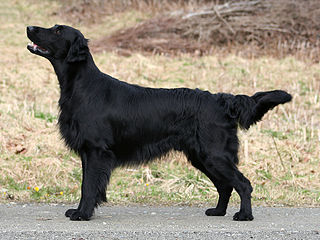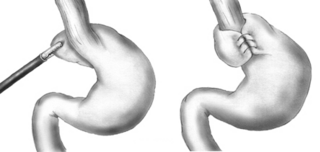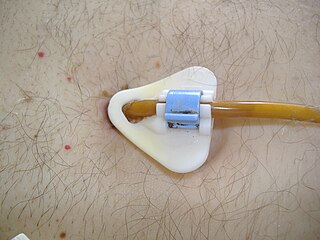Related Research Articles

The Great Dane is a large sized dog breed originating from Germany. The Great Dane descends from hunting dogs from the Middle Ages used to hunt wild boar and deer, and as guardians of German nobility. It is one of the two largest dog breeds in the world, along with the Irish Wolfhound.

A hiatal hernia or hiatus hernia is a type of hernia in which abdominal organs slip through the diaphragm into the middle compartment of the chest. This may result in gastroesophageal reflux disease (GERD) or laryngopharyngeal reflux (LPR) with symptoms such as a taste of acid in the back of the mouth or heartburn. Other symptoms may include trouble swallowing and chest pains. Complications may include iron deficiency anemia, volvulus, or bowel obstruction.

The Flat-coated Retriever is a gundog breed originating from England. It was developed as a retriever both on land and in the water.

Gastric dilatation volvulus (GDV), also known as gastric dilation, twisted stomach, or gastric torsion, is a medical condition that affects dogs in which the stomach becomes overstretched and rotated by excessive gas content. The word bloat is often used as a general term to mean gas distension without stomach torsion, or to refer to GDV.
Neutering, from the Latin neuter, is the removal of an animal's reproductive organ, either all of it or a considerably large part. The male-specific term is castration, while spaying is usually reserved for female animals. Colloquially, both terms are often referred to as fixing. In male horses, castrating is referred to as gelding. An animal that has not been neutered is sometimes referred to as entire or intact.

The Weimaraner is a large dog that was originally bred as a hunting dog in the early 19th century. Early Weimaraners were used by royalty for hunting large game such as boar, bear and deer. As the popularity of hunting large game began to decline, Weimaraners were used for hunting smaller animals like fowl, rabbits and foxes.

A Nissen fundoplication, or laparoscopic Nissen fundoplication when performed via laparoscopic surgery, is a surgical procedure to treat gastroesophageal reflux disease (GERD) and hiatal hernia. In GERD, it is usually performed when medical therapy has failed; but, with a Type II (paraesophageal) hiatus hernia, it is the first-line procedure. The Nissen fundoplication is total (360°), but partial fundoplications known as Thal, Belsey, Dor, Lind, and Toupet fundoplications are alternative procedures with somewhat different indications and outcomes.

Percutaneous endoscopic gastrostomy (PEG) is an endoscopic medical procedure in which a tube is passed into a patient's stomach through the abdominal wall, most commonly to provide a means of feeding when oral intake is not adequate. This provides enteral nutrition despite bypassing the mouth; enteral nutrition is generally preferable to parenteral nutrition. The PEG procedure is an alternative to open surgical gastrostomy insertion, and does not require a general anesthetic; mild sedation is typically used. PEG tubes may also be extended into the small intestine by passing a jejunal extension tube through the PEG tube and into the jejunum via the pylorus.

A laparoscopic adjustable gastric band, commonly called a lap-band, A band, or LAGB, is an inflatable silicone device placed around the top portion of the stomach to treat obesity, intended to decrease food consumption.

The health of dogs is a well studied area in veterinary medicine.
Banding is a medical procedure which uses elastic bands for constriction. Banding may be used to tie off blood vessels in order to stop bleeding, as in the treatment of bleeding esophageal varices. The band restricts blood flow to the ligated tissue, so that it eventually dies and sloughs away from the supporting tissue. This same principle underlies banding as treatment for hemorrhoids.

Gastric antral vascular ectasia (GAVE) is an uncommon cause of chronic gastrointestinal bleeding or iron deficiency anemia. The condition is associated with dilated small blood vessels in the pyloric antrum, which is a distal part of the stomach. The dilated vessels result in intestinal bleeding. It is also called watermelon stomach because streaky long red areas that are present in the stomach may resemble the markings on watermelon.
Sleeve gastrectomy or vertical sleeve gastrectomy, is a surgical weight-loss procedure, typically performed laparoscopically, in which approximately 75 - 85% of the stomach is removed, along the greater curvature, which leaves a cylindrical, or "sleeve"-shaped stomach the size of a banana. Weight loss is effected not only through the reduction of the organ's size, but by the removal of the portion of it that produces ghrelin, the hormone that stimulates appetite. Patients can lose 50-70 percent of excess weight over the course of the two years that follow the surgery. The procedure is irreversible, though in some uncommon cases, patients can regain the lost weight, via resumption of deleterious habits, or dilation of the stomach over time, which can require gastric sleeve revision surgery to either repair the sleeve or convert it to another type of weight loss method that may produce better results, such as a gastric bypass or duodenal switch.

Veterinary surgery is surgery performed on animals by veterinarians, whereby the procedures fall into three broad categories: orthopaedics, soft tissue surgery, and neurosurgery. Advanced surgical procedures such as joint replacement, fracture repair, stabilization of cranial cruciate ligament deficiency, oncologic (cancer) surgery, herniated disc treatment, complicated gastrointestinal or urogenital procedures, kidney transplant, skin grafts, complicated wound management, and minimally invasive procedures are performed by veterinary surgeons. Most general practice veterinarians perform routine surgeries such as neuters and minor mass excisions; some also perform additional procedures.

A trocar is a medical or veterinary device used in minimally invasive surgery, typically made up of an awl, a cannula and often a seal, and some trocars also include a valve mechanism to allow for insufflation. Trocars are designed for placement through the chest and abdominal walls during thoracoscopic and laparoscopic surgery, and each trocar functions as a portal for the subsequent insertion of other endoscopic instruments such as graspers, scissors, staplers, etc., hence the more commonly used colloquial jargon "ports". Trocars also allow passive evacuation of excess gas or fluid from organs within the body.
Gastric volvulus or volvulus of stomach is a twisting of all or part of the stomach by more than 180 degrees with obstruction of the flow of material through the stomach, variable loss of blood supply and possible tissue death. The twisting can occur around the long axis of the stomach: this is called organoaxial or around the axis perpendicular to this, called mesenteroaxial. Obstruction is more likely in organoaxial twisting than with mesenteroaxial while the latter is more associated with ischemia. About one third of the cases are associated with a hiatus hernia. Treatment is surgical.

A giant dog breed is a breed of dog of gigantic proportions, sometimes described as a breed whose weight exceeds 45 kilograms (99 lb). Breeds sometimes described as giant breeds include the Great Dane, Newfoundland, St. Bernard and Irish Wolfhound. These breeds have seen a marked increase in their size since the 19th century as a result of selective breeding.
Veterinary anesthesia is anesthesia performed on non-human animals by a veterinarian or a Registered Veterinary Technician. Anesthesia is used for a wider range of circumstances in animals than in people, due to animals' inability to cooperate with certain diagnostic or therapeutic procedures. Veterinary anesthesia includes anesthesia of the major species: dogs, cats, horses, cattle, sheep, goats, and pigs, as well as all other animals requiring veterinary care such as birds, pocket pets, and wildlife.
Bloat may refer to:
References
- ↑ "Gastric Dilatation Volvulus (GDV), Bloat and Torsion", Dr. Ron Hines, All Creature Care, April 21, 2006.
- ↑ "Key gastrointestinal surgeries - Incisional gastropexy," by K. Watson & K.M. Tobias, Veterinary Medicine, Vol 101(4), 213+, 2006.
- ↑ "A rapid and strong laparoscopic-assisted gastropexy in dogs," C.A. Rawlings, T.L. Foutz, M.B. Mahaffey, et al., American Journal of Veterinary Research, Vol 62, pages 871–875, 2001.
- ↑ "Laparoscopic-assisted gastropexy," C.A. Rawlings, Journal of the American Animal Hospital Association,Vol 38(1), Pages: 15-19, 2002.
- ↑ "Intracorporeal suture reinforcement during laparoscopic gastropexy in dogs," F.M. Sanchez-Margallo, I. Diaz-Guemes, & J. Uson-Gargallo, Veterinary Record, Vol 160(23), Pages: 806-807, 2007.
- ↑ Glickman, LT; Lantz, GC; Schellenberg, DB; Glickman, NW (May 1, 1998). "A prospective study of survival and recurrence following the acute gastric dilatation-volvulus syndrome in 136 dogs". Journal of the American Animal Hospital Association . 34 (3): 253–259. doi:10.5326/15473317-34-3-253 – via Silverchair.